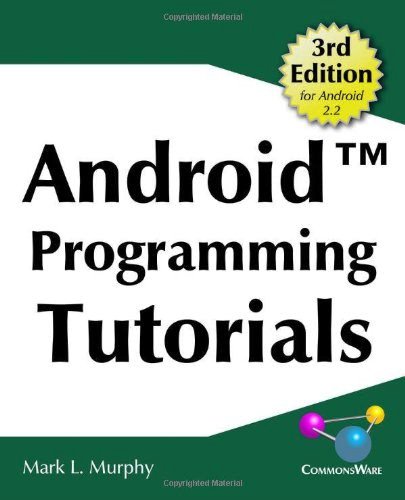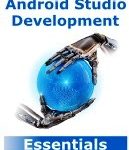| Book Name: | Android Programming Tutorials |
| Category: | Android |
| Free Download: | Available |
Android Programming Tutorials

Book Description
The Android Programming Guide shows you what you can do with Android, through a series of 40 individual exercises. The Android Programming Guide gives you hands-on instruction on how to create complex Android applications, using many of the technologies described in other CommonsWare Android books. These exercises guide you through the basics of building Android apps, through lots of cool Android features like internet access, location tracking, maps, built-in WebKit browser, camera, accelerometer, home screen widget and more. Full source code for all exercise answers is available, to help you if you get stuck. The Android Programming Guide becomes a great companion to other traditional Android books that simply tell you what’s possible.
Table of contents:
Android Programming Tutorials ……Page 2
Prerequisites……Page 16
Using the Tutorials……Page 17
What’s New……Page 19
Errata and Book Bug Bounty……Page 20
Source Code License……Page 21
Lifecycle of a CommonsWare Book……Page 22
Roster of Tutorials……Page 23
Step #1: Create the New Project……Page 28
Step #1: Eclipse……Page 29
Step #2: Command Line……Page 32
Step #1: Eclipse……Page 33
Step #2: Command Line……Page 34
Step #1: Generate the Application Skeleton……Page 38
Step #2: Modify the Layout……Page 39
Step #3: Support All Screen Sizes……Page 41
Step #5: Run the Application in the Emulator……Page 42
Step #7: Save the Form to the Model……Page 43
Further Reading……Page 45
Step #1: Switch to a TableLayout……Page 46
Step #2: Add a RadioGroup……Page 48
Step #3: Update the Model……Page 50
Step #4: Save the Type to the Model……Page 51
Extra Credit……Page 53
Further Reading……Page 54
Step #1: Hold a List of Restaurants……Page 56
Step #2: Save Adds to List……Page 57
Step #4: Add a ListView Widget……Page 58
Step #5: Build and Attach the Adapter……Page 60
Extra Credit……Page 62
Further Reading……Page 63
Step-By-Step Instructions……Page 64
Step #2: Design Our Row……Page 65
Step #3: Override getView(): The Simple Way……Page 67
Step #4: Create a RestaurantHolder……Page 68
Step #5: Recycle Rows via RestaurantHolder……Page 69
Further Reading……Page 72
Step #1: Rework the Layout……Page 74
Step #2: Wire In the Tabs……Page 76
Step #4: Update Our Restaurant Form On Clicks……Page 78
Step #5: Switch Tabs On Clicks……Page 79
Further Reading……Page 83
Step #1: Add Notes to the Restaurant……Page 84
Step #2: Add Notes to the Detail Form……Page 85
Step #3: Define the Option Menu……Page 87
Step #4: Show the Notes as a Toast……Page 88
Further Reading……Page 94
Step #1: Initialize the Progress Bar……Page 96
Step #2: Create the Work Method……Page 97
Step #3: Fork the Thread from the Menu……Page 98
Step #4: Manage the Progress Bar……Page 100
Extra Credit……Page 102
Further Reading……Page 103
Step #1: Lengthen the Background Work……Page 104
Step #2: Pause in onPause()……Page 105
Step #3: Resume in onResume()……Page 106
Further Reading……Page 113
Step #1: Review our Current Resources……Page 114
Step #2: Create a Landscape Layout……Page 115
Extra Credit……Page 118
Further Reading……Page 119
Step #1: Create a Stub SQLiteOpenHelper……Page 120
Step #2: Manage our Schema……Page 121
Step #4: Get Access to the Helper……Page 122
Step #5: Save a Restaurant to the Database……Page 123
Step #6: Get the List of Restaurants from the Database……Page 124
Step #7: Change our Adapter and Wrapper……Page 125
Step #8: Clean Up Lingering ArrayList References……Page 127
Step #9: Refresh Our List……Page 128
Extra Credit……Page 133
Further Reading……Page 134
Step #1: Create a Stub Activity……Page 136
Step #2: Launch the Stub Activity on List Click……Page 137
Step #3: Move the Detail Form UI……Page 138
Step #4: Clean Up the Original UI……Page 142
Step #5: Pass the Restaurant _ID……Page 143
Step #6: Load the Restaurant Into the Form……Page 144
Step #7: Add an “Add” Menu Option……Page 145
Step #8: Detail Form Supports Add and Edit……Page 146
Extra Credit……Page 159
Further Reading……Page 160
Step #1: Define the Preference XML……Page 162
Step #2: Create the Preference Activity……Page 163
Step #3: Connect the Preference Activity to the Option Menu……Page 164
Step #4: Apply the Sort Order on Startup……Page 168
Step #5: Listen for Preference Changes……Page 169
Step #6: Re-Apply the Sort Order on Changes……Page 170
Extra Credit……Page 171
Further Reading……Page 172
Step #1: Add a Stub onSaveInstanceState()……Page 174
Step #4: Fix Up the Landscape Detail Form……Page 175
Extra Credit……Page 177
Further Reading……Page 178
Step #1: Add a Feed URL to the Data Model……Page 180
Step #2: Update the Detail Form……Page 184
Step #3: Add a Feed Options Menu Item……Page 188
Step #4: Add Permissions and Check Connectivity……Page 189
Step #5: Install the RSS Library……Page 193
Step #6: Fetch and Parse the Feed……Page 194
Step #7: Display the Feed Items……Page 197
Extra Credit……Page 206
Further Reading……Page 207
Step #1: Create an Register a Stub IntentService……Page 208
Step #2: Move Feed Fetching and Parsing to the Service……Page 210
Step #3: Send the Feed to the Activity……Page 211
Step #4: Display the Feed Items, Redux……Page 213
Extra Credit……Page 219
Further Reading……Page 220
Step #1: Add Latitude and Longitude to the Data Model……Page 222
Step #2: Save the Restaurant in onPause()……Page 227
Step #3: Add a TextView and Options Menu Item for Location……Page 228
Step #4: Update the Permissions……Page 232
Step #5: Find Our Location Using GPS……Page 233
Step #6: Only Enable Options Menu Item If Saved……Page 236
Extra Credit……Page 242
Further Reading……Page 243
Step-By-Step Instructions……Page 244
Step #2: Create and Use a MapActivity……Page 245
Step #3: Create an ItemizedOverlay……Page 248
Step #4: Handle Marker Taps……Page 257
Extra Credit……Page 262
Further Reading……Page 263
Step-By-Step Instructions……Page 264
Step #1: Create a TimePreference……Page 265
Step #2: Collect Alarm Preferences……Page 268
Step #3: Set Up a Boot-Time Receiver……Page 269
Step #4: Manage Preference Changes……Page 271
Step #5: Display the Alarm……Page 278
Extra Credit……Page 284
Further Reading……Page 285
Step-By-Step Instructions……Page 286
Step #2: Display the Alarm, Redux……Page 287
Further Reading……Page 295
How To Get Started……Page 296
Step #2: Learn Java……Page 297
Step #1: Install the Base Tools……Page 298
Step #2: Install the SDKs and Add-Ons……Page 299
Install the ADT for Eclipse……Page 303
Install Apache Ant……Page 305
Set Up the Emulator……Page 306
Set Up the Device……Page 313
Step #1: Windows……Page 314
Step #2: OS X and Linux……Page 315
How to Import a Non-Eclipse Project……Page 318
How to Get To DDMS……Page 323
How to Create an Emulator……Page 325
How to Run a Project……Page 326
How to Get Past Eclipse……Page 327
Prerequisites……Page 16
Using the Tutorials……Page 17
What’s New……Page 19
Errata and Book Bug Bounty……Page 20
Source Code License……Page 21
Lifecycle of a CommonsWare Book……Page 22
Roster of Tutorials……Page 23
Step #1: Create the New Project……Page 28
Step #1: Eclipse……Page 29
Step #2: Command Line……Page 32
Step #1: Eclipse……Page 33
Step #2: Command Line……Page 34
Step #1: Generate the Application Skeleton……Page 38
Step #2: Modify the Layout……Page 39
Step #3: Support All Screen Sizes……Page 41
Step #5: Run the Application in the Emulator……Page 42
Step #7: Save the Form to the Model……Page 43
Further Reading……Page 45
Step #1: Switch to a TableLayout……Page 46
Step #2: Add a RadioGroup……Page 48
Step #3: Update the Model……Page 50
Step #4: Save the Type to the Model……Page 51
Extra Credit……Page 53
Further Reading……Page 54
Step #1: Hold a List of Restaurants……Page 56
Step #2: Save Adds to List……Page 57
Step #4: Add a ListView Widget……Page 58
Step #5: Build and Attach the Adapter……Page 60
Extra Credit……Page 62
Further Reading……Page 63
Step-By-Step Instructions……Page 64
Step #2: Design Our Row……Page 65
Step #3: Override getView(): The Simple Way……Page 67
Step #4: Create a RestaurantHolder……Page 68
Step #5: Recycle Rows via RestaurantHolder……Page 69
Further Reading……Page 72
Step #1: Rework the Layout……Page 74
Step #2: Wire In the Tabs……Page 76
Step #4: Update Our Restaurant Form On Clicks……Page 78
Step #5: Switch Tabs On Clicks……Page 79
Further Reading……Page 83
Step #1: Add Notes to the Restaurant……Page 84
Step #2: Add Notes to the Detail Form……Page 85
Step #3: Define the Option Menu……Page 87
Step #4: Show the Notes as a Toast……Page 88
Further Reading……Page 94
Step #1: Initialize the Progress Bar……Page 96
Step #2: Create the Work Method……Page 97
Step #3: Fork the Thread from the Menu……Page 98
Step #4: Manage the Progress Bar……Page 100
Extra Credit……Page 102
Further Reading……Page 103
Step #1: Lengthen the Background Work……Page 104
Step #2: Pause in onPause()……Page 105
Step #3: Resume in onResume()……Page 106
Further Reading……Page 113
Step #1: Review our Current Resources……Page 114
Step #2: Create a Landscape Layout……Page 115
Extra Credit……Page 118
Further Reading……Page 119
Step #1: Create a Stub SQLiteOpenHelper……Page 120
Step #2: Manage our Schema……Page 121
Step #4: Get Access to the Helper……Page 122
Step #5: Save a Restaurant to the Database……Page 123
Step #6: Get the List of Restaurants from the Database……Page 124
Step #7: Change our Adapter and Wrapper……Page 125
Step #8: Clean Up Lingering ArrayList References……Page 127
Step #9: Refresh Our List……Page 128
Extra Credit……Page 133
Further Reading……Page 134
Step #1: Create a Stub Activity……Page 136
Step #2: Launch the Stub Activity on List Click……Page 137
Step #3: Move the Detail Form UI……Page 138
Step #4: Clean Up the Original UI……Page 142
Step #5: Pass the Restaurant _ID……Page 143
Step #6: Load the Restaurant Into the Form……Page 144
Step #7: Add an “Add” Menu Option……Page 145
Step #8: Detail Form Supports Add and Edit……Page 146
Extra Credit……Page 159
Further Reading……Page 160
Step #1: Define the Preference XML……Page 162
Step #2: Create the Preference Activity……Page 163
Step #3: Connect the Preference Activity to the Option Menu……Page 164
Step #4: Apply the Sort Order on Startup……Page 168
Step #5: Listen for Preference Changes……Page 169
Step #6: Re-Apply the Sort Order on Changes……Page 170
Extra Credit……Page 171
Further Reading……Page 172
Step #1: Add a Stub onSaveInstanceState()……Page 174
Step #4: Fix Up the Landscape Detail Form……Page 175
Extra Credit……Page 177
Further Reading……Page 178
Step #1: Add a Feed URL to the Data Model……Page 180
Step #2: Update the Detail Form……Page 184
Step #3: Add a Feed Options Menu Item……Page 188
Step #4: Add Permissions and Check Connectivity……Page 189
Step #5: Install the RSS Library……Page 193
Step #6: Fetch and Parse the Feed……Page 194
Step #7: Display the Feed Items……Page 197
Extra Credit……Page 206
Further Reading……Page 207
Step #1: Create an Register a Stub IntentService……Page 208
Step #2: Move Feed Fetching and Parsing to the Service……Page 210
Step #3: Send the Feed to the Activity……Page 211
Step #4: Display the Feed Items, Redux……Page 213
Extra Credit……Page 219
Further Reading……Page 220
Step #1: Add Latitude and Longitude to the Data Model……Page 222
Step #2: Save the Restaurant in onPause()……Page 227
Step #3: Add a TextView and Options Menu Item for Location……Page 228
Step #4: Update the Permissions……Page 232
Step #5: Find Our Location Using GPS……Page 233
Step #6: Only Enable Options Menu Item If Saved……Page 236
Extra Credit……Page 242
Further Reading……Page 243
Step-By-Step Instructions……Page 244
Step #2: Create and Use a MapActivity……Page 245
Step #3: Create an ItemizedOverlay……Page 248
Step #4: Handle Marker Taps……Page 257
Extra Credit……Page 262
Further Reading……Page 263
Step-By-Step Instructions……Page 264
Step #1: Create a TimePreference……Page 265
Step #2: Collect Alarm Preferences……Page 268
Step #3: Set Up a Boot-Time Receiver……Page 269
Step #4: Manage Preference Changes……Page 271
Step #5: Display the Alarm……Page 278
Extra Credit……Page 284
Further Reading……Page 285
Step-By-Step Instructions……Page 286
Step #2: Display the Alarm, Redux……Page 287
Further Reading……Page 295
How To Get Started……Page 296
Step #2: Learn Java……Page 297
Step #1: Install the Base Tools……Page 298
Step #2: Install the SDKs and Add-Ons……Page 299
Install the ADT for Eclipse……Page 303
Install Apache Ant……Page 305
Set Up the Emulator……Page 306
Set Up the Device……Page 313
Step #1: Windows……Page 314
Step #2: OS X and Linux……Page 315
How to Import a Non-Eclipse Project……Page 318
How to Get To DDMS……Page 323
How to Create an Emulator……Page 325
How to Run a Project……Page 326
How to Get Past Eclipse……Page 327
Android Programming Tutorials, 3rd Edition
Author(s): Mark L Murphy
Publisher: CommonsWare, LLC, Year: 2010
ISBN: 0981678041,9780981678047
Android Programming Tutorials PDF
Related More Books
Thanks For Visiting Our Website https://www.freepdfbook.com To Support Us, Keep Share On Social Media.









![[PDF] Draw Buildings and Cities in 15 Minutes Draw Buildings and Cities in 15 Minutes pdf](https://www.freepdfbook.com/wp-content/uploads/2021/06/Draw-Buildings-and-Cities-in-15-Minutes-218x150.jpg)








![[PDF] Digital Image Processing An Algorithmic Introduction Using Java Digital Image Processing An Algorithmic Introduction Using Java](https://www.freepdfbook.com/wp-content/uploads/2022/06/Digital-Image-Processing-An-Algorithmic-Introduction-Using-Java.jpg)




![[PDF] 43 Years JEE ADVANCED + JEE MAIN Chapterwise & Topicwise Solved Papers 43 Years JEE ADVANCED (1978-2020) + JEE MAIN Chapterwise & Topicwise Solved Papers Physics PDF](https://www.freepdfbook.com/wp-content/uploads/2022/03/43-Years-JEE-ADVANCED-1978-2020.jpg)

![[PDF] Problems in Physical Chemistry for JEE (Main & Advanced) Problems in Physical Chemistry for JEE (Main & Advanced) Free PDF Book Download](https://www.freepdfbook.com/wp-content/uploads/2022/03/Problems-in-Physical-Chemistry-for-JEE-Main-Advanced.jpg)
![[PDF] Engineering Physics (McGraw Hill)](https://www.freepdfbook.com/wp-content/uploads/2021/05/bafc8c2685bb6823a9c56134f7fba5df.jpeg)

![[PDF] Engineering Chemistry By Shashi Chawla](https://www.freepdfbook.com/wp-content/uploads/2022/05/Theory-And-Practicals-of-Engineering-Chemistry-By-Shashi-Chawla-free-pdf-book.jpeg)
![[PDF] Chemistry: An Introduction to Organic, Inorganic & Physical Chemistry Chemistry: An Introduction to Organic, Inorganic & Physical Chemistry](https://www.freepdfbook.com/wp-content/uploads/2022/04/Chemistry-An-Introduction-to-Organic-Inorganic-Physical-Chemistry.jpg)
![[PDF] Essentials of Physical Chemistry Essentials of Physical Chemistry Free PDF Book by Bahl](https://www.freepdfbook.com/wp-content/uploads/2022/04/Essentials-of-Physical-Chemistry-bahl.jpg)
![[PDF] Biological control of plant-parasitic nematodes: soil ecosystem management in sustainable agriculture Biological control of plant-parasitic nematodes: soil ecosystem management in sustainable agriculture](https://www.freepdfbook.com/wp-content/uploads/2022/05/Biological-control-of-plant-parasitic-nematodes-soil-ecosystem-management-in-sustainable-agriculture.jpg)
![[PDF] Human Anatomy: Color Atlas and Textbook Human Anatomy: Color Atlas and Textbook Free PDF Book](https://www.freepdfbook.com/wp-content/uploads/2022/05/Human-Anatomy-Color-Atlas-and-Textbook.jpg)
![[PDF] Concepts of Biology Book [Free Download]](https://www.freepdfbook.com/wp-content/uploads/2022/05/Concepts-of-Biology.jpg)
![[PDF] Essentials of Biology [Free Download] Essentials of Biology Free PDF BOok Download](https://www.freepdfbook.com/wp-content/uploads/2022/05/Essentials-of-Biology-Free-PDF-Book-Downlaod.jpg)
![[PDF] Human Biology Book [Free Download]](https://www.freepdfbook.com/wp-content/uploads/2022/05/PDF-Human-Biology-Book-Free-Download.jpg)


